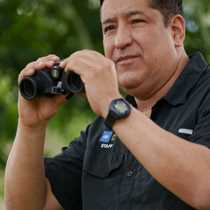This morning we visited an area on the western coast of Isabela, Urbina Bay, at the base of Alcedo Volcano. In 1954, almost half a square mile of the marine reef off this coast was uplifted almost instantaneously, by as much as 16 feet. All sorts of marine creatures, coral beds, coral heads, shells, barnacles, lobsters, sea stars, and tube worms to name few were left exposed. Today, after 50 years of the uplift, we were able to see evidence of this occurrence. But this is not the only attraction at Urbina Bay. This is one of the few places where after a short walk you can see giant tortoises and land iguanas in the wild. The population of tortoises here belong to Alcedo Volcano, one of the healthiest populations of giant tortoises nowadays. But things were not like that a few years ago, when thousands of introduced goats were competing for food with these giant and gentle creatures.
Life wasn’t easy for them even before the arrival of goats. Hundreds of tortoises were captured and killed for food or oil, since the discovery of the islands in 1535 until recently, when the Galapagos Islands were declared National Park, only 55 years ago!
So, what happened in the past few years that we were able to recover the population of giant tortoises here? An enormous effort was put together between scientists from the Charles Darwin Research Station, National Park Authorities, NGO’s and private companies such as Lindblad Expeditions, to achieve one of the greatest goals in nature: eradicate more than 200,000 goats from the islands – an effort never attempted before on any island or archipelago of similar size.
The Isabela Project, supported by Lindblad Expeditions-National Geographic guest donations, was successful beyond all expectations and now these gentle reptiles, that once faced extinction, are well on the road to recovery.
After learning about the geology of this site and the struggle for survival of some of the iconic species of Galapagos, it was time to move to a different location, this time to learn about the human history of the islands. The National Geographic Islander took us back north to visit a historic bay known as Tagus Cove where some interesting historic graffiti can be found along the cliffs of this cove. It was a favorite site for wayfarers and whalers, as its protected cove offered good shelter and the presence of a nearby freshwater lake and tortoises secured water and food for their survival.
Charles Darwin visited this site in 1835, and knowing this, today we were able to follow his footsteps along the trail up the rim of a tuff cone overlooking Darwin's Lake and beyond.
We also enjoyed kayaking and Zodiac rides along the fascinating coastline of Isabela and a deep water snorkeling outing where guests were spoiled by watching a “fleet” of Galapagos penguins swimming, dozens of sea turtles feeding on algae, a giant manta ray, an octopus and a flightless cormorant trying to swallow an eel bigger than his mouth, all together with the background of a beautiful sunset.
Just another normal day on the islands…









